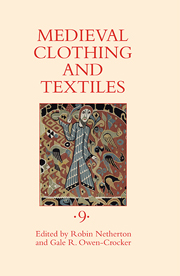Book contents
- Frontmatter
- Contents
- Illustrations
- Tables
- Contributors
- Preface
- 1 Bridal Gifts in Medieval Bari
- 2 The Marriage of the Year (1028)
- 3 Clothing as Currency in Pre-Norman Ireland?
- 4 Cistercian Clothing and Its Production at Beaulieu Abbey, 1269–70
- 5 Clothing and Textile Materials in Medieval Sweden and Norway
- 6 The Iconography of Dagged Clothing and Its Reception by Moralist Writers
- 7 Domestic Painted Cloths in Sixteenth-Century England: Imagery, Placement, and Ownership
- Recent Books of Interest
- Contents of Previous Volumes
1 - Bridal Gifts in Medieval Bari
Published online by Cambridge University Press: 05 July 2013
- Frontmatter
- Contents
- Illustrations
- Tables
- Contributors
- Preface
- 1 Bridal Gifts in Medieval Bari
- 2 The Marriage of the Year (1028)
- 3 Clothing as Currency in Pre-Norman Ireland?
- 4 Cistercian Clothing and Its Production at Beaulieu Abbey, 1269–70
- 5 Clothing and Textile Materials in Medieval Sweden and Norway
- 6 The Iconography of Dagged Clothing and Its Reception by Moralist Writers
- 7 Domestic Painted Cloths in Sixteenth-Century England: Imagery, Placement, and Ownership
- Recent Books of Interest
- Contents of Previous Volumes
Summary
The archives of the Basilica of St. Nicholas and of the Cathedral of Bari, capital city of Apulia, the southern Italian region that stretches along the coast of the Adriatic Sea (fig. 1.1), contain many public and private notarial acts, which have been partially published in the Codice Diplomatico Barese-Pugliese. Among the private documents, which include sales, donations, leases, wills, inheritances, etc., are marriage contracts. These are dated by the year of the empire or of the reign of the ruling sovereign, and the month (but not always the day). They may therefore be ascribed to the Byzantine or Greek period (888–1071), the Norman-Swabian period (1071–1266), or the Angevin period (1266–1442).
All the extant and edited marriage contracts, from the oldest fragmentary example dating to November 971 to the last, drawn up on Feb. 17, 1397, testify to the practical application of marriage law in force in the then multicultural city of Bari. This law derived from the merging of two originally distinct socio-juridical traditions, the Roman and the Germanic, and it survived for a surprisingly long time, throughout the various regimes that controlled the city until the end of the Middle Ages and beyond.
In the course of research for a book-length study on the penetration and subsequent assimilation of Langobard marriage institutions into the customary law in force in the city of Bari in the Middle Ages, I became aware of the rich evidence for garments, dress accessories, and personal jewellery contained in the accounts of dowry provisions in marriage contracts: It was the custom in Bari to include a detailed list of the goods with which the bride was endowed, along with a note specifying their monetary value.
- Type
- Chapter
- Information
- Medieval Clothing and Textiles 9 , pp. 1 - 44Publisher: Boydell & BrewerPrint publication year: 2013



